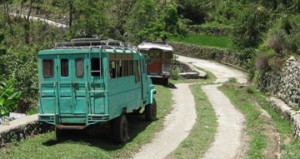We’ve found the driving on the main island of Luzon to be among the world’s worst driving experiences, on a par with some of the toughest conditions in Africa. On the other hand, hiring a car and driver isn’t a panacea either, as you will only pay surcharges for the driver’s time, meals, and hotels, but probably be paying his “commission” at each food and hotel stop as well. So perhaps you’re left to renting a car and driving the island yourself. Here’s what you’ll find:
1) Road maps are either non-existent, or worthless. In most cases, you’ll do as well with a national map of the Philippines. In any case, there is no map that will adequately describe the miserable road conditions, among the worst in Asia.
2) With the exception of a few roads around Manila, and the expressways, roads are always under construction, and as a rule, only fit for a 4-wheel drive vehicle with high clearance. Classic examples include the road from Sagada to Bontoc, and the Bessang Pass to Bontoc. Any map will indicate these are significant routes, but both are under construction, and the Bessang route is missing a bridge over a river not fordable by a sedan.
3) There are no signs. Period. Oh, you might get a road sign every 50 km or so, but you’ve got to ask constantly. What signs there are can be contradictory. Traveling from Baguio to Manila, we were directed to the high speed expressway. 3 km or so later, we made a left turn at a sign that said “Manila,” only to find that we were instead being sent to the old road, 20 km to the east. Welcome to the Philippines.
4) No streetlights, even on expressways. Why would a country build a significant high speed toll road, and not include lighting? As a result, everyone drives with high beams and at extremely high speeds at night, trying to get off this dangerous roadway as soon as possible.
Corruption is the clue. The lack of signs and lighting, and poor road conditions, have been cited by numerous individuals as prime examples of the corruption involved in the highway department. Signs and lighting were budgeted, but the money went into politicians’ pockets. Roads will never be finished in our lifetimes, because there’s always plenty to skim off the top. That’s a fact of life in the Philippines. So if you do drive yourself, here are our recommendations:
1) Rent a 4-wheel vehicle with good clearance. You’ll be needing it.
2) Carry a GPS, with a map of the Philippines pre-loaded. The road info will probably not be all that important, but you’ll know your direction and distance to population areas.
3) Unless you’re on an expressway, figure 3-4 hours per every 100 km.
The good news is that Filipinos are friendly, polite, and willing to help with directions as you meet them along the way. Do remember that frustrated as you are with the asininity of the Philippine highway system, the fellow you ask for directions is not to blame, and is just as much a victim of corrupt politics as you are.

Leave a Reply